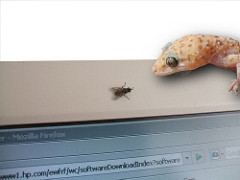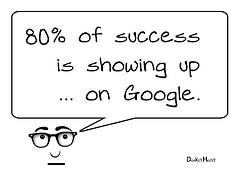|
|
|
Wednesday, June 22nd, 2016
 Everyone complains about information overload. Everyone complains about information overload.
Playwright Richard Forman has a term for it.
“Pancake people – spread wide and thin as we connect with that vast network of information accessed by the mere touch of a button”.
Psychologist and behavioral neuroscientist Daniel Levitin, author of the upcoming book The Organized Mind: Thinking Straight in the Age of Information Overload, recommends retraining your brain.
“Our brains are equipped to deal with the world the way it was many thousands of years ago when we were hunter-gatherers. Back then the amount of information that was coming at us was much less and it came at us much more slowly.”
But Salesforce CEO Mark Benioff has a much simpler solution.
“I deleted my Facebook account completely. I found it was just overwhelming me. I’m only on Twitter, I’m on SalesforceOne, which is my internal one for work, I’m on email, and that’s it. And I’m limited to that. I’m trying not to take on more stuff. I was with a friend this weekend, he’s got his Twitter, his Facebook, he has his Snapchat, he’s got all these – too much.”
Of course, part of the overload is work-related, but it’s amazing how much is pure trivia driven by FoMO and/or the need to impress by sounding knowledgeable about a twist in Game of Thrones.
You are the only person who can evaluate just how necessary your various information streams are sooner rather than later.
Because even the smallest stream adds to the river in which it is oh, so easy to drown.
Then you need gather your courage, follow Benioff’s lead and shut down the unnecessary streams.
Your sanity will thank you.
Flickr image credit: Cambodia4kids.org Beth Kanter
Posted in Personal Growth | No Comments »
Wednesday, May 25th, 2016

Like porn, privacy evil seems to be in the eye of the beholder (me), but not in Google’s eye.
I’ve written in the past about the fluidity of evil and the privacy difference between Apple and the rest (Google, Facebook, etc.)
Now I see that Google is going above and beyond in the name of “user convenience.”
Google will need to convince people that having AI manage your life is more convenient than it is creepy.
I get that many of you like the idea and have no problem with suggestions and tracking, etc., so you may have no interest past this point.
But those of you who consider tracking more akin to stalking and are happily capable of managing your own life/world will find the following truly valuable.
In a truly informative and useful article Business Insider provides links so you can see what Google knows about you.
Better yet, it walks you through how to delete and control how Google uses it and what it sells to third parties.
It’s a long way from the privacy Europe enjoys, but it’s sure better than nothing.
Thanks, BI!
Image credit: Lamerie
Posted in Culture | No Comments »
Tuesday, July 28th, 2015

Last Friday we looked at the disturbing number of entrepreneurs who suffer from anxiety and depression, exacerbated by the pressures of founding a startup, and too often find their solace in suicide.
Mark Suster wrote how the same problems often haunt success.
Today’s New York Times had a complimentary article, Campus Suicide and the Pressure of Perfection.
There are several compelling points to consider;
- almost all are young;
- they are high achievers recognized for ‘crushing it’ — whatever ‘it’ happens to be;
- they are driven to live up to outside expectations; and
- they constantly compare themselves to others’ external images as depicted in social media.
The acts required to “keep up with the Joneses” have changed significantly from my under-35 days.
Back then it was your neighbors and school/social/professional circles that comprised the Joneses.
Now it is the no-holds-barred world.
The existential question “Why am I here?” is usually followed by the equally confounding “How am I doing?” In 1954, the social psychologist Leon Festinger put forward the social comparison theory, which posits that we try to determine our worth based on how we stack up against others.
Growing up and in the years since ‘how am I doing’ was never my focus, because I never fit in; never was part of any crowd and certainly never told I was special.
Fortunately, I wasn’t competitive; in fact, competitive has never been part of my personal vocabulary.
Somehow I’ve always known that no matter what I accomplished there would always be people who were richer/smarter/thinner/more popular/more whatever than I.
Unlike those described in the aforementioned articles.
And the pressures have increased exponentially for those susceptible.
In the era of social media, such comparisons take place on a screen with carefully curated depictions that don’t provide the full picture. Mobile devices escalate the comparisons from occasional to nearly constant.
“Curated” is the polite way to say that people lie — not only to convince the world, but probably to convince themselves.
Don’t get caught in this trap; teach yourself to talk about how you feel — to at least one real person, preferably more.
And take time to be there for others who are struggling.
Flickr image credit: Rodney Campbell
Posted in Business info | 3 Comments »
Friday, June 5th, 2015
A Friday series exploring Startups and the people who make them go. Read all If the Shoe Fits posts here
 More and more research is showing that real creativity is a more solo function than a team effort. More and more research is showing that real creativity is a more solo function than a team effort.
Susan Cain spells this out in a thoughtful LinkedIn post that is well worth your time, especially if you are a young founder raised on social media, with a penchant for crowdsourcing and Yelp.
Consider the words of Steve Wozniak in his memoir iWoz.
Most inventors and engineers I’ve met are like me—they’re shy and they live in their heads. They’re almost like artists. In fact, the very best of them are artists. And artists work best alone where they can control an invention’s design without a lot of other people designing it for marketing or some other committee. I don’t believe anything really revolutionary has been invented by committee. If you’re that rare engineer who’s an inventor and also an artist, I’m going to give you some advice that might be hard to take. That advice is: Work alone. You’re going to be best able to design revolutionary products and features if you’re working on your own. Not on a committee. Not on a team.
Then read, digest and tweak Cain’s ideas to fit your situation, then put the concepts to work in your company.
Image credit: HikingArtist
Posted in If the Shoe Fits, Innovation | No Comments »
Wednesday, May 20th, 2015

You know that old saying, ‘do not run mouth unless brain is engaged’?
These days there should be a rule about not posting to social media unless brain is engaged.
Better yet, some kind of hardware similar to the gadget that prevents a car from starting if the driver can’t pass a breathalyzer test.
Media is full of stories about people who were fired for what they tweeted.
The rationalization I hear from various people is that it won’t happen to them because “I’m different.” They say that “they (those fired) were nobodies, i.e., low-level workers or unemployed, while they are “professionals,” i.e., they have clout.
Once I stop laughing I remind them of all those with clout who sent stupid tweet that cost them their jobs.
Now I just send them a link listing 13 Twitter-savvy somebodys fired for their tweets.
Whether you’re a somebody or a nobody, read the list.
Then be sure your brain is engaged before you post a tweet — every time.
Flickr image credit: Bernard Goldbach
Posted in Business info | No Comments »
Monday, April 20th, 2015

Do you equate leadership to influence?
Does being labeled an “influencer” by LinkedIn or other social media make you a leader?
Not really.
True leadership is internal.
It’s a function of your MAP (mindset, attitude, philosophy™).
It starts by knowing both yourself and your MAP.
Knowing yourself refers to knowing what you’ve done.
Knowing your MAP means knowing why you did it.
Knowing both allows you to accurately evaluate where you are and where you’re going.
That knowledge is the rudder with which you can chart and achieve any course you choose.
Image credit: Jevgenijs Slihto
Posted in Personal Growth | 2 Comments »
Monday, April 6th, 2015

Do you like hearing “you did good” or the appropriate equivalent when you accomplish something, whether large or small?
It’s safe to say that 99.9% of us do.
It’s called validation and it’s what takes our accomplishments out of our heads and gives them objective, real-world presence.
We measure our success based on our accomplishments, so outside validation has always been important.
Validation used to come came from our family, friends, bosses, colleagues — people we knew and who knew us.
Now people crave and seek validation from strangers they have never met and probably never will.
Society seems to have decided that recognition and approval from thousands via virtual communities and soulless apps have more value than the same from flesh and blood people.
Personally, I find it very weird, but I guess it’s just one more thing that makes me a digital dinosaur.
Image credit: DonkeyHotey
Posted in Culture, Personal Growth | No Comments »
Wednesday, March 11th, 2015

Yesterday we looked at how our society moved from a culture of narrow connections to one of mobility and a broader acceptance of those totally unconnected to us to the current regression back to responding mainly (often only) to those to whom we are already connected — no matter how tenuous or irrelevant the connection.
In other words, we went from silos to free-range and back to silos.
Ola Joseph says, “Diversity is not about how we differ. Diversity is about embracing one another’s uniqueness.”
But today we reinforce our particular silos through social media.
Where once we were broadened, 21st Century media provides the means to assure ourselves that our opinions are shared by both followers and followed.
Trolls aren’t new, either; they are the modern version of poison pen letters.
According to Auden, “Civilizations should be measured by the degree of diversity attained and the degree of unity retained.”
However, the anonymity of online communications allows us to unleash our thoughts with no civilizing or cultural leavening.
And so we join the ranks of trolls in one area, while bemoaning their existence in another.
Image credit: Roshan Vyas
Posted in Culture, Personal Growth | No Comments »
Tuesday, March 10th, 2015

For centuries the most important information upon meeting someone new was where were they from and who was their family.
Once that was known the involved parties would be able to figure out how they were connected; crucial information in order to do business or move forward with any kind of relationship.
Then World War II and the post war automobile culture changed our social structure forever.
Strangers met, formed businesses, fell in love and married — all without the introductions and recommendations of family, friends or other associates.
Fifty-plus years later we have reverted to our previous attitudes regarding introductions — now based on professional/personal networks, social media and the crowd-sourced opinions of strangers.
After attending a fintech conference (see his upcoming post Thursday) Ajo Fod, founder of Alpha Sangha, left a comment on KG Charles-Harris’s post regarding the help that entrepreneurs really need.
The most effective resource at this point in my start-up is introductions to the right people. Meeting them directly doesn’t seem to have the same effect as an introduction.
Entrepreneur of not, what can you do to offset a lack of introductions?
Here is what I told Ajo.
You are right in your analysis that the best connections are the result of introductions and this seems especially true when it comes to investors.
Partly it is a function of trust, i.e., I trust you because I trust the person who introduced us, which is ridiculous as I wrote in Who Do You Trust? in 2008 and KG touched on a couple of years ago in If the Shoe Fits: Facing Reality.
Beyond repeating what you already know, such as working your network, finding connections, etc., I suggest that you put part of your focus on developing your peer-and-below network, not just those who can directly help, by reaching out and helping them. One way to accomplish this is by responding on forums like Quora.
Use your expertise to build your visibility, so that even with no intro you will be a more known quantity when they google you.
Not great, but you have to start somewhere.
Image credit: George Tims
Posted in Ducks In A Row | No Comments »
Tuesday, February 17th, 2015

Yesterday’s post focused on the difference between mindful and mindless social media usage as private individuals.
The problem is more far-reaching when the person speaking heads or publicly represents the company, whether as an employee or celebrity spokesperson.
Foot-in-mouth disease isn’t anything new.
What is new is its global reach and immortal status.
The problem is best summed up in a comment from Lee Rainie, a Pew Research Center specialist in the social influence of digital technologies.
“Despite all of the warnings, all of the evidence to the contrary and all the material floating around proving otherwise, people still think that when they’re sitting alone typing something out, they know exactly who their audience is. But the specific character of digital information is that it’s replicable, repeatable, and there are lots of outlets now that are interested in these stories.”
One further warning.
The “outlets” mentioned above — old and new media, pundits, individuals and trolls — like nothing better than to take that private email, joking tweet or casual image and spin it into something that supports or illustrates their own viewpoint — no matter how badly they distort it or how warped the application.
Image credit: US Geological Survey
Posted in Business info | No Comments »
|
 Subscribe to
Subscribe to
MAPping Company Success
About Miki 
Clarify your exec summary, website, etc.
Have a quick question or just want to chat? Feel free to write or call me at 360.335.8054
The 12 Ingredients of a Fillable Req
CheatSheet for InterviewERS
CheatSheet for InterviewEEs™
Give your mind a rest. Here are 4 quick ways to get rid of kinks, break a logjam or juice your creativity!
Creative mousing
Bubblewrap!
Animal innovation
Brain teaser
The latest disaster is here at home; donate to the East Coast recovery efforts now!
Text REDCROSS to 90999 to make a $10 donation or call 00.733.2767. $10 really really does make a difference and you'll never miss it.
And always donate what you can whenever you can
The following accept cash and in-kind donations: Doctors Without Borders, UNICEF, Red Cross, World Food Program, Save the Children
*/
?>About Miki
About KG
Clarify your exec summary, website, marketing collateral, etc.
Have a question or just want to chat @ no cost? Feel free to write
Download useful assistance now.
Entrepreneurs face difficulties that are hard for most people to imagine, let alone understand. You can find anonymous help and connections that do understand at 7 cups of tea.
Crises never end.
$10 really does make a difference and you’ll never miss it,
while $10 a month has exponential power.
Always donate what you can whenever you can.
The following accept cash and in-kind donations:
|
 Everyone complains about information overload.
Everyone complains about information overload.





 More and more research is showing that real creativity is a more solo function than a team effort.
More and more research is showing that real creativity is a more solo function than a team effort.






